Caring for Antique
Marble
by Bob Brooke
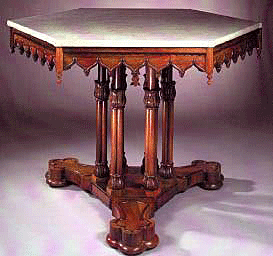 The
Victorians loved marble. They though it gave a look of elegance to their
high-styled furniture, especially Renaissance and Rococo Revival and
Eastlake pieces. However, as beautiful as it is, it’s also a vulnerable
natural stone surface. It’s soft stone is susceptible to stains and
damage. So how can you keep your beautiful investment clean and
protected without accidentally causing further damage? The
Victorians loved marble. They though it gave a look of elegance to their
high-styled furniture, especially Renaissance and Rococo Revival and
Eastlake pieces. However, as beautiful as it is, it’s also a vulnerable
natural stone surface. It’s soft stone is susceptible to stains and
damage. So how can you keep your beautiful investment clean and
protected without accidentally causing further damage?
Everyday Maintenance
Before your marble gets damaged through neglect, start a regular
maintenance procedure. To clean it, use warm water, then dry it
immediately with a soft cloth. If your marble has gotten extremely
dirty, you can add a little dishwashing liquid to the water.
Use a soft brush, rinse thoroughly—traces of soap that remain in the
marble will yellow. Be sure to wipe away any sudsy residue from the
marble surface. If you have streaks and a dull finish, it may be because
there’s still soap residue on the surface. Rinse the sponge or cloth
again with hot water and wring it out thoroughly to remove most of the
excess water. Wipe over the surface again to remove any residue. Dry
immediately and polish with a chamois.
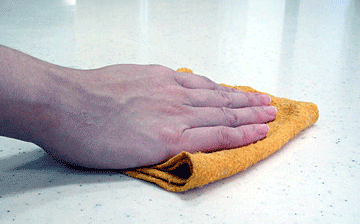 Some
museum decorative arts curators recommend using distilled water for the
cleaning process. You can also purchase commercial cleaning products
made specifically for marble surfaces. It’s important to work quickly to
avoid letting solutions soak into the marble more than necessary. Some
museum decorative arts curators recommend using distilled water for the
cleaning process. You can also purchase commercial cleaning products
made specifically for marble surfaces. It’s important to work quickly to
avoid letting solutions soak into the marble more than necessary.
Washing a marble bust of any kind is more difficult because the marks of
dirty water dripping down may be impossible to remove. The best advice
is to start at the top, using solution or water sparingly, then mop dry
as you go. For routine dusting of marble, use a soft brush or a feather
duster. A cloth tends to rub dirt into the stone.
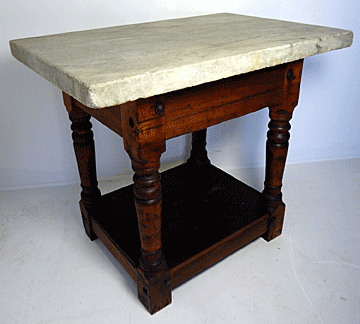 Get
in the habit of using coasters under drinking glasses and mugs to
protect your marble top from staining and etching. Avoid placing sharp-
or rough-bottomed objects directly on the marble top to avoid
scratching. Finally, apply a commercial marble sealer to prevent stains
and make the marble easy to clean. Get
in the habit of using coasters under drinking glasses and mugs to
protect your marble top from staining and etching. Avoid placing sharp-
or rough-bottomed objects directly on the marble top to avoid
scratching. Finally, apply a commercial marble sealer to prevent stains
and make the marble easy to clean.
Also, avoid letting citrus or alcohol products sit on the marble surface
as it can etch and dull it. Keep hot items off of marble. Always use a
trivet or hot pad for protection. And use a glass or plastic tray to
hold cosmetics on marble vanity surfaces. Make sure they have felt
pieces underneath to keep from scratching the marble.
Some experts recommend using a microcystalline wax on marble tops after
they’ve been cleaned and sealed. Others believe wax isn’t necessary.
Protection from Stains
A major concern is the protection of marble from stains, since it is,
like other natural stones, quite absorbent. Oils in particular are
destructive; an oily stain will strike into the marble, yellowing it and
ruining its appearance. A great deal of damage has been done by
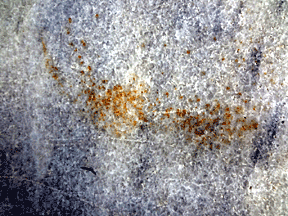 people
who were oiling the wood of a piece of furniture (which they probably
shouldn't have been doing anyway), and either spilled the oil or set the
bottle down on a marble top. Any oil accidentally spilled onto marble
must be removed immediately, and an absorbent material like plaster of
Paris or talcum powder liberally applied. Later the plaster or talc can
simply be dusted off. people
who were oiling the wood of a piece of furniture (which they probably
shouldn't have been doing anyway), and either spilled the oil or set the
bottle down on a marble top. Any oil accidentally spilled onto marble
must be removed immediately, and an absorbent material like plaster of
Paris or talcum powder liberally applied. Later the plaster or talc can
simply be dusted off.
Since marble is a very porous stone, time is of the essence when it
comes to removing stains. Immediately blot all spills, avoid rubbing as
it may cause spreading of the stain. The longer a stain sits, the more
likely it is to soak in and will be nearly impossible to remove.
Removing Stains
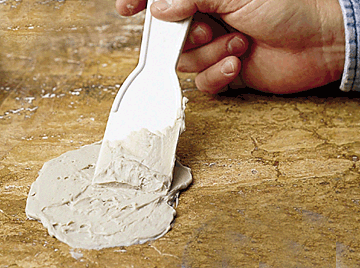 To
remove stains from marble, mix some powdered whiting, available at home
improvement stores, with water in a small bowl until it forms a thick
paste about the consistency of peanut butter. To
remove stains from marble, mix some powdered whiting, available at home
improvement stores, with water in a small bowl until it forms a thick
paste about the consistency of peanut butter.
Apply the paste to the stained area, keeping it only on the stain. The
layer of paste should be about one fourth of an inch thick and overlap
the stain about a half an inch.
Cover the area with plastic wrap and tape the edges down. Allow this to
set on the stain until it’s dry. This can take up to two days.
When the paste is completely dry, use a cloth or sponge to wipe away the
paste.
Rinse with clean water. Clean the area as normal and allow it to dry.
If the stain is still there, you may need to repeat the above steps
several times, each time removing more of the stain.
To read
more of my articles, please
visit
my Web site.
<
Back to Caring for Your Collections
Archives
Next Article > |
